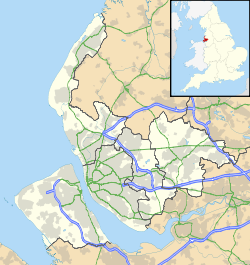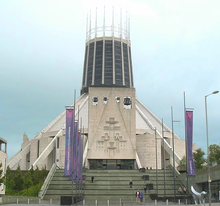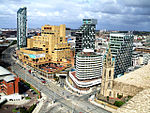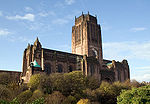- Liverpool Metropolitan Cathedral
-
Liverpool Metropolitan Cathedral Liverpool Metropolitan Cathedral Church of Christ the King 
Liverpool Metropolitan Cathedral, Mount PleasantShown within Merseyside 53°24′17″N 2°58′08″W / 53.4047°N 2.9688°WCoordinates: 53°24′17″N 2°58′08″W / 53.4047°N 2.9688°W Location Liverpool, Merseyside Country England Denomination Roman Catholic Website liverpoolmetrocathedral.org.uk Architecture Architect(s) Sir Edwin Lutyens, Frederick Gibberd Specifications Height 84.86m[1] Administration Diocese Liverpool Province Liverpool Clergy Bishop(s) Archbishop Patrick Altham Kelly Dean Anthony O'Brien Laity Director of music Timothy Noon Organist(s) Richard Lea The Metropolitan Cathedral Church of Christ the King (usually known as Liverpool Metropolitan Cathedral) is a Roman Catholic cathedral in Liverpool, Merseyside, England. The cathedral is the seat of the Archbishop of Liverpool[2] and the Roman Catholic Archdiocese of Liverpool.[3] The Metropolitan Cathedral is one of two cathedrals in the city. The other, the Anglican Cathedral Church of Christ in Liverpool, is about 0.5 miles (0.8 km) to the south.[4] The Grade II* Metropolitan Cathedral is one of Liverpool's many listed buildings. It is sometimes known locally as "Paddy's Wigwam" or the "Mersey Funnel".
The cathedral's architect was Englishman Frederick Gibberd, the winner of a worldwide design competition. Construction began in 1962, and took five years. Earlier designs for a Catholic cathedral in Liverpool had been proposed in 1853, 1933, and 1953, but none were completed.
Contents
History
Pugin's design
During the Irish potato famine (1845-1852) the Catholic population of Liverpool increased dramatically. About half a million Irish, who were predominantly Catholic, fled to England to escape the famine; many embarked from Liverpool to travel to North America while others remained in city.[5] Because of the increase in the Catholic population, the co-adjutor Bishop of Liverpool, Alexander Goss (1814–1872), saw the need for a cathedral. The location he chose was the grounds of St. Edward's College on St. Domingo Road, Everton.[6]
In 1853 Goss, then bishop, awarded the commission for the building of the new cathedral to Edward Welby Pugin (1833–1875).[7] By 1856 the Lady Chapel of the new cathedral had been completed. Due to financial resources being diverted to the education of Catholic children, work on the building ceased at this point and the Lady Chapel – now named Our Lady Immaculate – served as parish church to the local Catholic population until its demolition in the 1980s.[8]
Lutyens' design
Following the purchase of the present 9-acre (36,000 m2) site at Brownlow Hill in 1930,[6] Sir Edwin Lutyens (1869–1944) was commissioned to provide a design which would be an appropriate response to the Giles Gilbert Scott-designed Neo-gothic Anglican cathedral then being built further along Hope Street.[9]
Lutyens' design was intended to create a massive structure that would have become the second-largest church in the world. It would have had the world's largest dome, with a diameter of 168 feet (51 m) compared to the 137.7 feet (42.0 m) diameter on St. Peter's Basilica in Vatican City.[10] Building work based on Lutyens' design began on Whit Monday, 5 June 1933,[10] being paid for mostly by the contributions of working class Catholics of the burgeoning industrial port.[11] In 1941 the restrictions of World War II wartime and a rising cost from £3 million to £27 million[12] (£991 million as of 2011),[13] forced construction to stop. In 1956 work recommenced on the crypt, which was finished in 1958. Thereafter, Lutyens' design for the Cathedral was considered too expensive and was abandoned with only the crypt complete.[10]
Scott's reduced design
After the ambitious design by Lutyens fell through, Adrian Gilbert Scott, brother of Giles Gilbert Scott (architect of the Anglican Cathedral), was commissioned in 1953 to work on a smaller cathedral design with a £4 million budget (£83 million as of 2011).[13] He proposed a scaled-down version of Lutyens' building, retaining the massive dome. Scott's plans were criticised and the building did not go ahead.[6]
Gibberd's design
The present Cathedral was designed by Sir Frederick Gibberd (1908–84). Construction began in October 1962 and less than five years later, on the Feast of Pentecost 14 May 1967, the completed cathedral was consecrated.[6] Soon after its opening, it began to exhibit architectural flaws. This led to the cathedral authorities suing Frederick Gibberd for £1.3 million on five counts, the two most serious being leaks in the aluminium roof and defects in the mosaic tiles, which had begun to come away from the concrete ribs.[14]
Architecture
Concept
The competition to design the Cathedral was held in 1959. The requirement was first, for a congregation of 3,000 (which was later reduced to 2,000) to be able to see the altar, in order that they could be more involved in the celebration of the Mass, and second, for the Lutyens crypt to be incorporated in the structure. Gibberd achieved these requirements by designing a circular building with the altar at its centre, and by transforming the roof of the crypt into an elevated platform, with the cathedral standing at one end of it.[15]
Exterior
The Cathedral is built in concrete with a Portland stone cladding and a lead covering to the roof.[16] Its plan is circular, having a diameter of 195 feet (59 m), with 13 chapels around its perimeter.[17] The shape of the Cathedral is conical, and it is surmounted by a tower in the shape of a truncated cone.[16] The building is supported by 16 boomerang-shaped concrete trusses which are held together by two ring beams, one at the bends of the trusses and the other at their tops. Flying buttresses are attached to the trusses, giving the cathedral its tent-like appearance. Rising from the upper ring beam is a lantern tower, containing windows of stained glass, and at its peak is a crown of pinnacles.[17]
The entrance is at the top of a wide flight of steps leading up from Hope Street. Above the entrance is a large wedge-shaped structure. This acts as a bell tower, the four bells being mounted in rectangular orifices towards the top of the tower. Below these is a geometric relief sculpture, designed by William Mitchell, which includes three crosses. To the sides of the entrance doors are more reliefs in fibreglass by Mitchell, which represent the symbols of the Evangelists.[16][18] The steps which lead up to the cathedral were only completed in 2003, when a building which obstructed the steps path was acquired and demolished by developers.[19]
Interior
The focus of the interior is the altar which faces the main entrance. It is made of white marble from Skopje, Macedonia, and is 10 feet (3 m) long. The floor is also of marble in grey and white designed by David Atkins. The benches, concentric with the interior, were designed by Frank Knight. Above is the tower with large areas of stained glass designed by John Piper and Patrick Reyntiens in three colours, yellow, blue and red, representing the Trinity. The glass is 1 inch (3 cm) thick, the pieces of glass being bonded with epoxy resin, in concrete frames. Around the perimeter is a series of chapels. Some of the chapels are open, some are closed by almost blank walls, and others consists of a low space under a balcony. Opposite the entrance is the Blessed Sacrament Chapel, above which is the organ. Other chapels include the Lady Chapel and the Chapel of Saint Joseph. To the right of the entrance is the Baptistry.[20]
On the altar the candlesticks are by R. Y. Goodden and the bronze crucifix is by Elisabeth Frink. Above the altar is a baldachino designed by Gibberd as a crown-like structure composed of aluminum rods, which incorporates loudspeakers and lights. Around the interior are metal Stations of the Cross, designed by Sean Rice. Rice also designed the lectern, which includes two entwined eagles. In the Chapel of Reconciliation (formerly the Chapel of Saint Paul of the Cross), the stained glass was designed by Margaret Traherne. Stephen Foster designed, carved and painted the panelling in the Chapel of St Joseph. The Lady Chapel contains a statue of the Virgin and Child by Robert Brumby and stained glass by Margaret Traherne. In the Blessed Sacrament Chapel is a reredos and stained glass by Ceri Richards and a small statue of the Risen Christ by Arthur Dooley. In the Chapel of Unity (formerly the Chapel of Saint Thomas Aquinas) is a bronze stoup by Virginio Ciminaghi, and a mosaic by Hungarian artist Georg (George) Mayer-Marton of the Pentecost which was moved from the Church of the Holy Ghost, Netherton, when it was demolished in 1989. The gates of the Baptistery were designed by David Atkins.[21]
Structural problems
The Cathedral had been built quickly and economically, and this led to problems with the fabric of the building, including leaks. A programme of repairs was carried out during the 1990s. The building had been faced with mosaic tiles, but these were impossible to repair and were replaced with glass-reinforced plastic, which gave it a thicker appearance. The aluminium in the lantern was replaced by stainless steel, and the slate paving of the platform was replaced with concrete flags.[17]
Cathedral crypt
The crypt under Liverpool Metropolitan Cathedral is the only part that was built according to Lutyens' design before construction stopped due to World War II; in 1962 Frederick Gibberd's design was built upon the Lutyens crypt.[10] Structurally the crypt is built of brick and granite from quarries in Penryn, Cornwall.[22] Each year the crypt plays host to the Liverpool Beer Festival which attracts visitors, not only from all over Britain but also Continental Europe and places such as the United States and Australia.[23]
Refurbishment
A £3 million refurbishment of the crypt was completed in 2009 and was officially re-opened on May 1 ,that same year, by the Duke of Gloucester.[24] The refurbishment included new east and west approaches, archive provision, rewiring and new lighting, catering facilities, a new chancel, new toilets and revamped exhibitions.[25]
Organ
Built by J. W. Walker and Sons, the organ was completed only two days before the opening of the cathedral in 1967.[26] Made as an integral part of the new cathedral, the architect, Frederick Gibberd, saw the casework as part of his brief and so designed the striking front to the organ. Using decorative woodwork, Gibberd was inspired by the innovative use of the pipes at Coventry Cathedral and the Royal Festival Hall and so arranged the shiny zinc pipes and brass trumpets en chamade to contrast strikingly with concrete pillars which surround the organ.[27]
Specifications
The organ has four manuals, 88 speaking stops and 4565 pipes. It works by way of air pressure, controlled by an electric current and operated by the keys of the organ console; this opens and closes valves within the wind chests, allowing the pipes to speak. This type of motion is called electro-pneumatic action.[27][28]
Organ stops Organ pipes Great Organ 15 1220 Swell organ 16 1159 Positive Organ 14 793 Solo Organ 15 893 Accompanimental Organ 7 0 Pedal organ 21 500 Total 88 4565 Gallery
See also
- List of cathedrals in the United Kingdom
- Architecture of Liverpool
References
- Notes
- ^ "Metropolitan Cathedral of Christ the King – Facts". www.emporis.com. http://www.emporis.com/en/wm/bu/?id=110845. Retrieved 2009-06-28.
- ^ "Welcome to Liverpool's Metropolitan Cathedral". Liverpool Metropolitan Cathedral. http://www.liverpoolmetrocathedral.org.uk/. Retrieved 2009-07-09.
- ^ "The Archdiocese of Liverpool". Archdiocese of Liverpool. Archived from the original on 2008-06-19. http://web.archive.org/web/20080619034840/http://www.archdiocese-of-liverpool.co.uk/. Retrieved 2009-11-11.
- ^ "Liverpool Cathedral – Local Interest". Pilgrims' Association. 2006. http://www.cathedralsplus.org.uk/index.php/front_end/member/86/about.html. Retrieved 2009-06-28.
- ^ Redford & Chaloner (1976), pp. 156–157.
- ^ a b c d "History of the Metropolitan Cathedral". Liverpool Metropolitan Cathedral. http://www.liverpoolmetrocathedral.org.uk/history/history.html. Retrieved 2009-07-04.
- ^ Hammond, Lisa (June/July 2008). "No.14: Liverpool Metropolitan Cathedral". www.mondoarc.com. http://www.mondoarc.com/built_with_light/226507/no14_liverpool_metropolitan_cathedral.html. Retrieved 2009-06-28.
- ^ Evans, dave (7 April 2005). "St Domingo Road, Everton". Dave Evans. http://www.emanuensis.btinternet.co.uk/domingo.htm. Retrieved 2009-06-28.
- ^ "Liverpool Cathedral". Visit North West. http://www.visitnorthwest.com/liverpool/liverpool-cathedral.htm. Retrieved 2009-07-05.
- ^ a b c d Edmondson, Rick. "Liverpool Metropolitan Cathedral". Rick Edmondson. http://www.unfinishedbuildings.org/liverpool.html. Retrieved 2009-07-05.
- ^ Cusack, Andrew (January 2007). "The Greatest Building Never Built". andrew cusack. http://www.andrewcusack.com/2007/01/11/the-greatest-building-never-built/#more. Retrieved 2009-07-05.
- ^ "'Lutyens Cathedral', by Sir Edward Lutyens". Walker Art Gallery. March 2007. http://liverpoolmuseums.org.uk/picture-of-month/displaypicture.asp?venue=2&id=321. Retrieved 2009-07-20.
- ^ a b UK CPI inflation numbers based on data available from Lawrence H. Officer (2010) "What Were the UK Earnings and Prices Then?" MeasuringWorth.
- ^ Baillieu, Amanda (February 1994). "Paddy's wigwam needs repairs". The Independent. http://www.independent.co.uk/arts-entertainment/art/news/architecture-paddys-wigwam-needs-repairs-1394451.html. Retrieved 2009-07-16.
- ^ Pollard and Pevsner, pp. 356–357
- ^ a b c Images of England: Roman Catholic Cathedral, Liverpool. English Heritage. http://www.imagesofengland.org.uk/details/default.aspx?id=359118. Retrieved 30 July 2009
- ^ a b c Pollard and Pevsner, p. 357
- ^ Pollard and Pevsner, p. 358
- ^ "Liverpool Metropolitan Cathedral Steps". Neptune Developments Ltd. http://www.neptunedevelopments.co.uk/developments/showdevelopment.asp?recordid=64. Retrieved 17 April 2010.
- ^ Pollard and Pevsner, pp. 358–359
- ^ Pollard and Pevsner, p. 359
- ^ (in English) L'POOL CATHEDRAL (aka CATHEDRALS OF LIVERPOOL) 1940. British Pathe Ltd. http://www.britishpathe.com/record.php?id=37381.
- ^ Shennan, Paddy (16 February). "30 reasons to be cheerful about the Liverpool Beer Festival". Liverpool Echo. http://www.liverpoolecho.co.uk/liverpool-life/liverpool-lifestyle/2010/02/16/30-reasons-to-be-cheerful-about-the-liverpool-beer-festival-100252-25840550/. Retrieved 6 April 2010.
- ^ Sharpe, Laura (April 29 2009). "First glimpse of refurbished Crypt at Liverpool's Metropolian Cathedral". Liverpool Daily Post. http://www.liverpooldailypost.co.uk/liverpool-news/regional-news/2009/04/29/exclusive-glimpse-of-the-refurbished-lutyens-crypt-at-liverpool-s-metropolian-cathedral-92534-23498179/. Retrieved 2009-07-24.
- ^ "Cathedral's crypt is transformed". BBC. May 2009. http://news.bbc.co.uk/1/hi/england/merseyside/8032678.stm. Retrieved 2009-07-24.
- ^ "The Organ in the Metropolitan Cathedral, Liverpool". www.liv.ac.uk. http://www.liv.ac.uk/~spmr02/organ/metropolitan.html. Retrieved 2009-07-23.
- ^ a b "The cathedral organs". Liverpool Metropolitan Cathedral. http://www.liverpoolmetrocathedral.org.uk/Content/MusictheChoir/TheCathedralOrgan.aspx. Retrieved 2009-07-23.
- ^ Cook, James (1998). "electro pneumatic windchests". James H. Cook. http://www.concertartist.info/organhistory/works/works11.htm. Retrieved 2009-07-23.
- Bibliography
- Pollard, Richard; Nikolaus Pevsner (2006). The Buildings of England: Lancashire: Liverpool and the South-West. New Haven & London: Yale University Press. ISBN 0 300 10910 5.
- Redford, Arthur; Chaloner, William Henry (1976). Labour migration in England, 1800–1850. Manchester University Press. ISBN 0719006368.
- Denizeau, Gérard (2009). Larousse des cathédrales. Paris, Larousse. ISBN 9782035839619.
Further reading
- Gibberd, Frederick (1968). Metropolitan Cathedral of Christ the King, Liverpool. Architectural P. ISBN 0851393888.
External links
- Liverpool Metropolitan Cathedral official website
- The cathedral that never was - exhibition of Lutyens' cathedral model at the Walker Art Gallery
 External media
External mediaImages 
Images of Cathedral interior 
Blessings Exhibition of 800 Years of Liverpool Videos 
Construction of Cathedral Crypt 
First mass in Cathedral Crypt Cathedrals of the Catholic Church in Great Britain and Ireland Catholicism England and Wales Province of WestminsterProvince of BirminghamProvince of LiverpoolProvince of SouthwarkProvince of CardiffCardiff · Swansea · WrexhamOther diocesesScotland Province of St Andrews and EdinburghProvince of GlasgowIreland Province of ArmaghProvince of CashelProvince of DublinProvince of TuamList of cathedrals in Ireland · List of cathedrals in England and Wales · List of cathedrals in Scotland · List of cathedrals in Northern Ireland Categories:- Roman Catholic cathedrals in England & Wales
- Churches in Liverpool
- Visitor attractions in Liverpool
- Grade II* listed buildings in Liverpool
Wikimedia Foundation. 2010.















